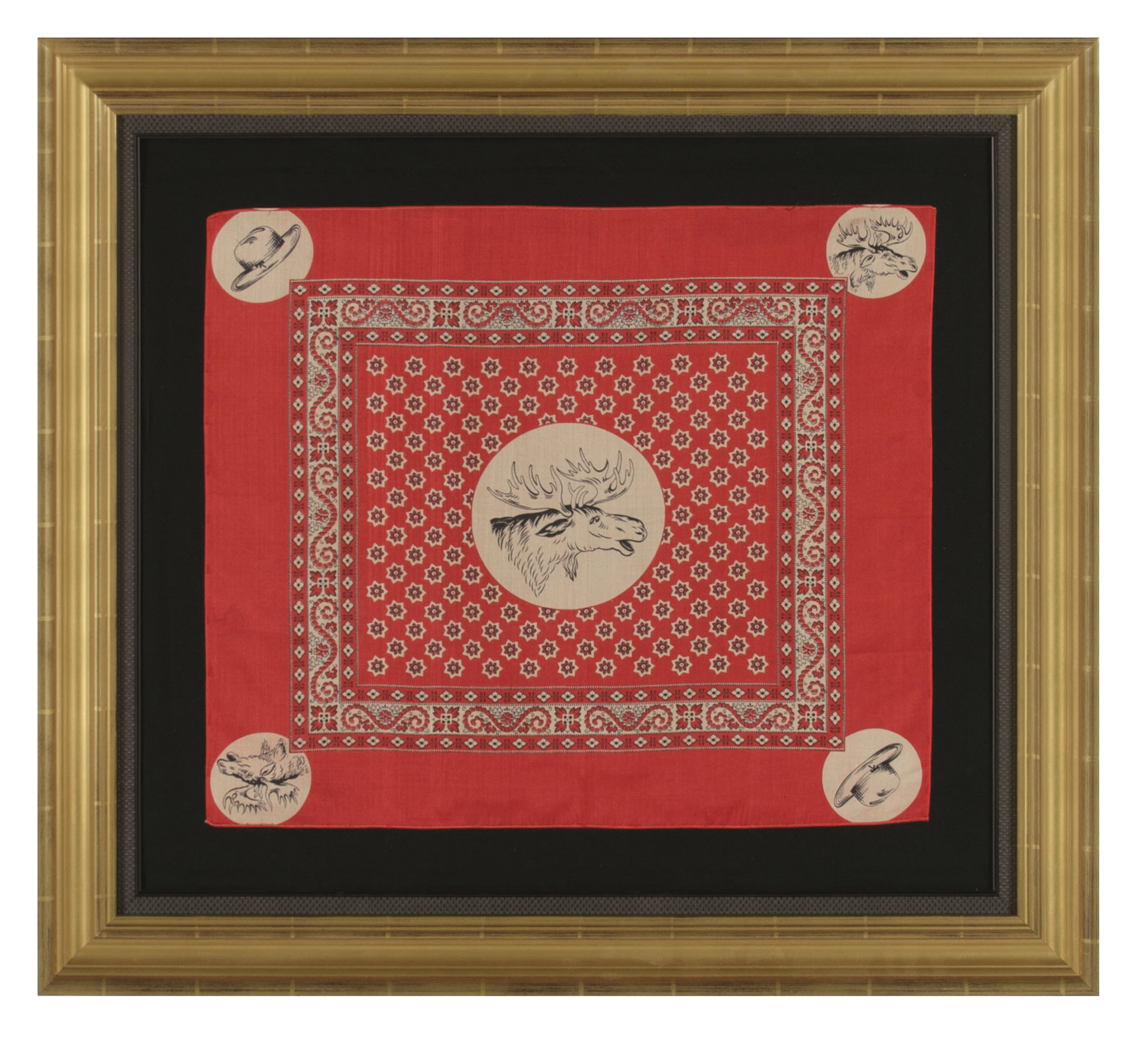
| |
SILK CAMPAIGN KERCHIEF FEATURING A PROMINENT BULL MOOSE, MADE FOR THE 1912 PRESIDENTIAL RUN OF TEDDY ROOSEVELT, WHEN HE RAN ON THE NATIONAL PROGRESSIVE PARTY TICKET |
|
| Available: |
Sold |
| Frame Size (H x L): |
30.75" x 33.5" |
| Flag Size (H x L): |
20.25" x 23.25" |
|
| Description....: |
|
SILK CAMPAIGN KERCHIEF FEATURING A PROMINENT BULL MOOSE, MADE FOR THE 1912 PRESIDENTIAL RUN OF TEDDY ROOSEVELT, WHEN HE RAN ON THE NATIONAL PROGRESSIVE PARTY TICKET:
Printed silk kerchief, made for the 1912 presidential campaign of Theodore Roosevelt when he ran on the Progressive Party ticket. In this scarce example, the typical geometric design of a western bandanna is made personal to Roosevelt by the inclusion of a large center medallion with the image of a bull moose. This is flanked by smaller medallions in each corner containing both bull moose and illustrations of his famous Rough Riders slouch hat.
Roosevelt nicknamed his the “Bull Moose Party” in comic yet serious notation to his bull-headed nature. This manner of choosing a mascot fell in line with the Republican and Democrat selections of the Elephant and Donkey. The presence of such a large moose makes this unlike other examples, none of which feature the mascot as prominently and many of which don’t feature it at all. Before 1912, no party mascots were illustrated on campaign textiles, so this is among the very first to do so.
Roosevelt had declined to run in 1908, following a long-standing tradition that Presidents were expected to leave office after two terms. He appointed his friend, William Howard Taft, as his successor, who won and served the next four years. During his forthcoming administration, a rift grew between Taft and Roosevelt, who each became leaders of the Republican Party's two ever-spreading wings. The progressives opposed the court system, favored restrictions on women's employment, favored conservation, were more favorable toward labor unions, and opposed tariffs. The conservatives were pro-business and insisted on judicial supremacy. Taft became identified with the conservative wing, while Roosevelt was the leader of the progressive wing.
By 1910 the split was deep. Roosevelt ran for nomination on the Republican ticket but lost to Taft, so in true T.R. fashion, he waved off defeat and set out on his own. Despite rather serious opposition from his many Republican friends, he jumped into the ring with no apparent reason to believe that he might actually lose. In the forthcoming election he did beat Taft, gaining 88 electoral votes versus Taft’s almost non-existent count of 8. In doing so he became the only man in history to place second on an independent ticket. He was slaughtered by Wilson, however, who received 435 votes in the Electoral College and served two terms in the nation’s highest office. A disgruntled Roosevelt retreated to what he loved best, risk and adventure. He traveled to the Amazon jungle, where he ran an uncharted river and nearly perished.
An example of the kerchief resides in the collection of the Smithsonian and is documented in “Threads of History” by Collins, Smithsonian Press, 1979 (item 939, pg. 373). Collins served as the Smithsonian's curator of political history and his landmark text is considered the definitive reference on political flag and textile collecting.
Mounting: The kerchief has been hand-stitched to 100% cotton twill, black in color, that has been was washed to reduce excess dye. An acid-free agent was added to the wash to further set the dye and the fabric was heat-treated for the same purpose. The mount was then placed in a very high quality gilded French molding with a distinctive early American profile, to which a black rippled liner with gold highlights was added. The glazing is U.V. protective Plexiglas.
Condition: Excellent. |
|
|
|
| Collector Level: |
Intermediate-Level Collectors and Special Gifts |
|
| Flag Type: |
|
|
| Star Count: |
|
|
| Earliest Date of Origin: |
1912 |
|
| Latest Date of Origin: |
1912 |
|
| State/Affiliation: |
|
|
| War Association: |
|
|
| Price: |
SOLD |
|
| |
Views: 2774 |
|
|
|

